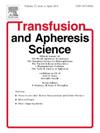The impact of age and gravidity on CD34+ yields in female peripheral blood stem cell donors
IF 1.2
4区 医学
Q4 HEMATOLOGY
引用次数: 0
Abstract
Donor age has long been recognized as negatively affecting CD34 + yield following Peripheral Blood Stem Cell (PBSC) mobilization. However, its impact on male versus female donors has not been separately examined. In addition, the potential influence of pregnancy history on female donors remains underexplored. The retrospective study extracted donation data from 267 female donors with known pregnancy history, grouped by age and number of gravidities, and CD34 + yields post-PBSC mobilization were compared. The study revealed a decline in CD34 + yields with increasing donor age, but an elevation in yields among female donors aged 41–50, a pattern not seen with male donors. There was no difference in yields between nulligravida donors and those with 2 or 3 gravidities, and the latter cohort showed significantly higher yields than donors with 1 or 4 + gravidities. For donors in their 40 s, CD34 + yields were either higher than or similar to those of younger donors with the same number of gravidities, suggesting an additional effect of this age group on stem cell yields. Nevertheless, recipients’ engraftment outcomes were comparable among donors with varying numbers of gravidities and nulligravida donors. This study demonstrates that female donors aged 41–50 have CD34 + yields similar to male donors, and those with 2–3 previous pregnancies exhibit CD34 + yields comparable to those of nulligravida donors and significantly higher than those of other gravidity groups. These findings suggest that age and pregnancy history influence stem cell mobilisation, emphasizing the need for further research into their underlying biological mechanisms and clinical significance.
年龄和妊娠对女性外周血干细胞供者CD34+产量的影响
长期以来,供体年龄一直被认为对外周血干细胞(PBSC)动员后CD34 + 的产量有负面影响。然而,它对男性和女性捐赠者的影响还没有单独研究。此外,怀孕史对女性献血者的潜在影响仍未得到充分探讨。回顾性研究提取了267名已知妊娠史的女性献血者的捐献数据,按年龄和妊娠次数分组,比较pbsc动员后CD34 + 的产率。该研究显示,随着供体年龄的增加,CD34 + 的产量下降,但在41-50岁的女性供体中,产量升高,而在男性供体中没有发现这种模式。无重力供体与2或3重力供体的产量没有差异,后者的产量明显高于1或4重力( + )供体。对于40岁 年龄段的供体,CD34 + 的产量高于或类似于具有相同重力数的年轻供体,这表明这个年龄段对干细胞产量有额外的影响。然而,受者的移植结果在不同数量的重力供体和无重力供体之间是可比的。本研究表明,年龄在41-50岁的女性供者CD34 + 的产出率与男性供者相似,而有过2-3次妊娠的女性CD34 + 的产出率与无妊娠供者相当,明显高于其他妊娠组。这些发现表明,年龄和妊娠史影响干细胞动员,强调需要进一步研究其潜在的生物学机制和临床意义。
本文章由计算机程序翻译,如有差异,请以英文原文为准。
求助全文
约1分钟内获得全文
求助全文
来源期刊
CiteScore
3.60
自引率
5.30%
发文量
181
审稿时长
42 days
期刊介绍:
Transfusion and Apheresis Science brings comprehensive and up-to-date information to physicians and health care professionals involved in the rapidly changing fields of transfusion medicine, hemostasis and apheresis. The journal presents original articles relating to scientific and clinical studies in the areas of immunohematology, transfusion practice, bleeding and thrombotic disorders and both therapeutic and donor apheresis including hematopoietic stem cells. Topics covered include the collection and processing of blood, compatibility testing and guidelines for the use of blood products, as well as screening for and transmission of blood-borne diseases. All areas of apheresis - therapeutic and collection - are also addressed. We would like to specifically encourage allied health professionals in this area to submit manuscripts that relate to improved patient and donor care, technical aspects and educational issues.
Transfusion and Apheresis Science features a "Theme" section which includes, in each issue, a group of papers designed to review a specific topic of current importance in transfusion and hemostasis for the discussion of topical issues specific to apheresis and focuses on the operators'' viewpoint. Another section is "What''s Happening" which provides informal reporting of activities in the field. In addition, brief case reports and Letters to the Editor, as well as reviews of meetings and events of general interest, and a listing of recent patents make the journal a complete source of information for practitioners of transfusion, hemostasis and apheresis science. Immediate dissemination of important information is ensured by the commitment of Transfusion and Apheresis Science to rapid publication of both symposia and submitted papers.

 求助内容:
求助内容: 应助结果提醒方式:
应助结果提醒方式:


